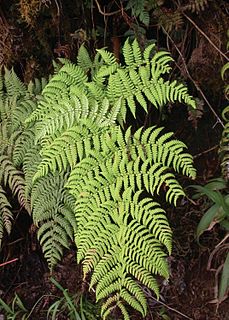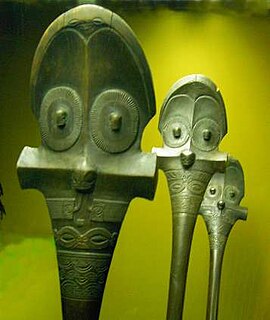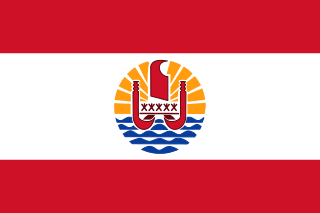The name Washington Island refers to:
The Marquesas Islands were the first of the island groups discovered by European explorers in the Pacific. Over the centuries, these Polynesian islands have been variously known by a number of names.
Uahuka is a genus of linyphiid spiders endemic to the Marquesas Islands. The genus was first described in 1935 by Berland. It was transferred to the family Symphytognathidae in 1972 by H.W. Levi, but this was rejected by Brignoli in 1980. As of 2017, it contains 2 species, U. affinis and U. spinifronsU. spinifrons has only been found on Ua Huka and U. affinis has only been found on Hiva Oa, a larger island about 50 km to the southeast of Ua Huka.
Nukuhiva is a genus of spiders with a single species, Nukuhiva adamsoni, that occurs only on the Marquesas Islands in French Polynesia. It is in the wolf spider family, Lycosidae. It has been found on Nuku Hiva and on Ua Huka, a smaller island about 25 km (16 mi) to the east.

The ultramarine lorikeet is a species of parrot in the family Psittaculidae, endemic to the Marquesas Islands. Its natural habitats are subtropical or tropical moist lowland forest, subtropical or tropical moist montane forest and plantations. It is threatened mainly by introduction of the black rat and also by deforestation.
The Iphis monarch, or Ua Huka flycatcher, is a species of bird in the family Monarchidae. It is endemic to French Polynesia. Its natural habitats are subtropical or tropical dry forests, subtropical or tropical moist lowland forests, subtropical or tropical moist shrubland, and plantations.
The Marquesas Islands are the island group farthest from any continent in the world, lying between 400 and 600 miles south of the equator and approximately 1,000 miles (1,600 km) northeast of Tahiti. They fall naturally into two geographical divisions: the northern group, consisting of Eïao, Hatutu (Hatutaa), Motu One, and the islands centered on the large island of Nuku Hiva: Motu Iti, Ua Pou, Motu Oa and Ua Huka, and the southern group of Fatu Uku, Tahuata, Moho Tani (Motane), Terihi, Fatu Hiva and Motu Nao, clustered around the main island of Hiva `Oa.

Dryopteris macropholis is a species of fern. It is distributed on the Marquesas Islands.
The Ua Huka rail is an extinct species of flightless bird in the Rallidae, or rail family.
The Marquesas cuckoo-dove, also referred to as the Marquesan cuckoo-dove, is an extinct species of bird in the pigeon family. It was endemic to the Marquesas Islands of French Polynesia. It was described from subfossil bones recovered from the Hane archaeological site on the island of Ua Huka. The cuckoo-dove was a relatively large species, with long legs; its limb proportions suggesting a more terrestrial lifestyle than its congeners. The dove's extinction occurred either upon or shortly after the colonisation of the islands by ancient Polynesians.

Hokatu is a village on the island of Ua Huka in the Marquesas Islands in French Polynesia.
Nestor Ohu is a politician of the Marquesas Islands. He is the mayor of the island of Ua Huka, governing over 592 inhabitants. He was elected in May 2014 for a term of six years until 2020.
Hitikau is a volcanic mountain of Ua Huka, in the Marquesas Islands of Polynesia. It has an elevation of 884 metres (2,900 ft), the highest point of the island, and lies to the northeast of the village of Hane.

Hane is the largest settlement on the island of Ua Huka, in the Marquesas Islands of French Polynesia. Hane, a notable archaeological site, has a smaller population than the capital of Vaipae'e.

Wood carving in the Marquesas Islands is a practice undertaken by many of the local master craftsmen, who are known as tuhuna. The tuhuna are not only adept at wood carving, but are also skilled at tattoo art and adze manufacture. Marquesan wooden crafts are considered among the finest in French Polynesia; they are highly sought after, and of consistently high quality, although weaving, basket-making, and pareu painting is more popular, especially among women artisans. Paul Gauguin noted the artistic sense of decoration of the Marquesas and appreciated the "unheard of sense of decoration" in their creative art forms.

The Marquesan Dog or Marquesas Islands Dog is an extinct breed of dog from the Marquesas Islands. Similar to other strains of Polynesian dogs, it was introduced to the Marquesas by the ancestors of the Polynesian people during their migrations. Serving as a tribal totems and religious symbols, they were sometimes consumed as meat although less frequently than in other parts of the Pacific because of their scarcity. These native dogs are thought to have become extinct before the arrival of Europeans, who did not record their presence on the islands. Petroglyphic representations of dogs and the archaeological remains of dog bones and burials are the only evidence that the breed ever existed. Modern dog population on the island are the descendants of foreign breeds later reintroduced in the 19th century as companions for European settlers.










